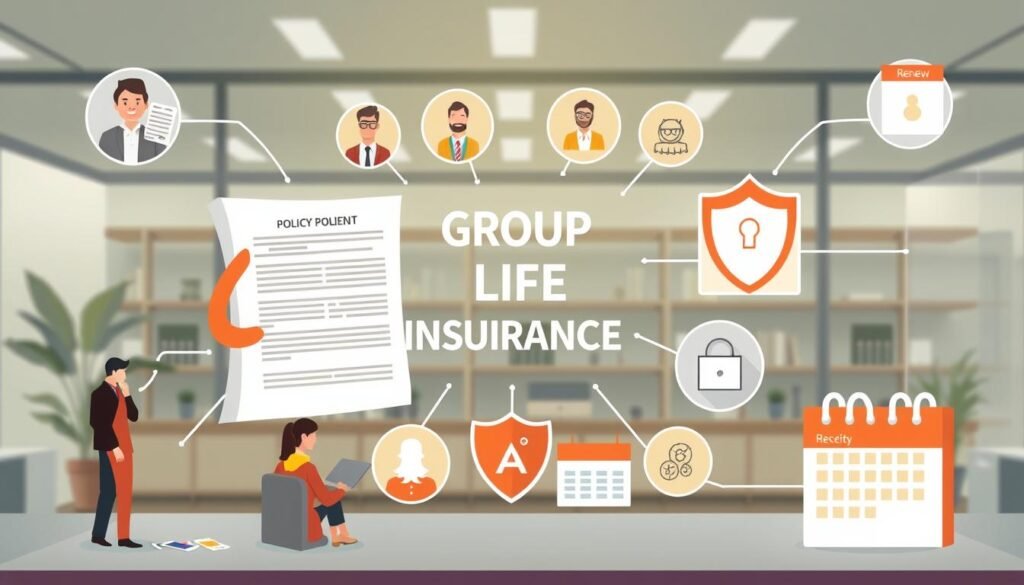Group life insurance policies are usually written as annually renewable term coverage. This makes it a cost-effective option for employers to offer this important benefit. In fact, 57% of private company employees and 83% of government employees get life insurance through their jobs1.
These group term life insurance policies are cheaper than individual life insurance. This leads to high participation rates among employees.
The standard coverage amount for group term life insurance is based on the employee’s annual salary. Premiums are mainly based on the insured’s age1. Employers often cover most or all of the premiums for basic coverage. Employees may pay extra for more coverage1.
Key Takeaways
- Group life insurance policies are typically written as annually renewable term coverage.
- 57% of private company employees and 83% of government employees have access to life insurance through the workplace.
- Group term life insurance is relatively inexpensive compared to individual life insurance.
- Standard coverage amounts are usually tied to the employee’s annual salary.
- Employers often pay most or all of the premiums for basic group term life insurance coverage.
Understanding Group Life Insurance Policies
Group life insurance covers a group of people, like employees or members of a group. It’s different from individual life insurance because it’s one contract for everyone. This contract has set benefits and payouts for all covered2.
Getting group life insurance is easy. You usually don’t need a medical exam. This makes it a simple and affordable option for many2. It’s also cheaper than individual life insurance because the risk is spread out2.
The amount of coverage varies, but it’s often between $10,000 and $50,000. Sometimes, it’s based on how much you earn. Some policies also offer extra coverage for accidents2.
One big difference is that group life insurance stops when you leave the group. But, some policies let you keep your coverage even after you’re no longer with the group.
Group life insurance comes in two types: term and universal. Term life insurance covers you for a set time, then you need a new policy2. Universal life insurance doesn’t expire and grows a cash value. It also lets you invest, giving more benefits over time2.
It’s important to know the differences between group and individual life insurance. This helps both individuals and organizations choose the right coverage for their needs.
“Roughly two-thirds of Americans rely on group life insurance from work, yet nearly half of individuals covered by group life insurance either don’t understand or only somewhat understand how it works.”3
Types of Group Life Insurance Policies
There are several types of group life insurance to consider. Employer-sponsored group life insurance is common, offered as part of employee benefits4. It’s often cheaper than individual policies, with premiums taken from paychecks5.
Association group life insurance is available through groups like professional organizations. You get coverage by being a member4. It’s a good option for those without employer coverage.
Credit life insurance pays off debts if you pass away. It’s great for those with mortgages or loans, as it protects loved ones from debt4.
Some plans offer voluntary life insurance for extra coverage. Employees can buy more for themselves or dependents4. Eligibility varies, but often requires work hours or group membership4.

It’s key to understand each group life insurance policy well. Look at coverage, eligibility, and extra benefits. This way, you can choose wisely and protect your loved ones45.
Essential Components of Group Life Insurance Policies
Group life insurance policies have key parts. Coverage amounts often match the employee’s salary, from $10,000 to $50,000 or more6. You can pick who gets the death benefit, giving peace of mind and control.
The policy terms and conditions are important. They cover the coverage period, renewal options, and what’s not covered. Some policies offer guaranteed issue and accelerated death benefits for serious illnesses6. The incontestability clause and grace period are also key, ensuring clarity and protecting the policyholder.
Coverage Amounts
Group life insurance usually offers low coverage amounts. These are often $20,000, $50,000, or one or two times the annual salary6. This coverage is often cheap, and sometimes it’s free for certain employees6.
Beneficiary Designations
Choosing a beneficiary is a big deal in group life insurance. Policyholders can pick who gets the death benefit. This ensures their loved ones are taken care of if they pass away.
Policy Terms and Conditions
The policy terms and conditions are detailed. They cover the policy’s duration, renewal options, and what’s not covered. Some policies also offer guaranteed issue and accelerated death benefits for serious illnesses6.
| Policy Component | Description |
|---|---|
| Incontestability Clause | A provision that prevents the insurer from contesting the policy after it has been in force for a certain period, typically two years. |
| Grace Period | A specified period of time during which the policyholder can make a late premium payment without the policy lapsing. |

“Group life insurance is a common employee benefit that aims to provide financial support to the families of insured employees in case of death while being part of the organization.”
How Premiums Are Calculated
Group life insurance premiums are based on several factors. These include the group’s size, the age of its members, and any health issues. This is important for evidence of insurability and supplemental coverage7.
Larger groups usually pay less because the risk is spread out. This makes the rates more favorable7. The age of employees also affects premiums, with rates increasing at certain ages7. The industry the group works in can also impact costs, with some being riskier than others.
Insurance companies use group underwriting to keep premiums low7. They need a large number of people covered to keep rates down7. This way, they can offer better deals to the group.
| Policy Type | Typical Premium Characteristics |
|---|---|
| Term Life Insurance | Usually have the least expensive premiums7 |
| Whole Life Insurance | Charge a set premium that remains the same7 |
| Universal Life Insurance | Offer flexibility in adjusting premiums yearly7 |
Premiums for group life insurance vary a lot. This depends on the policy type, coverage amount, and any extra benefits7. Knowing these factors helps employers and employees choose the right coverage.
Eligibility Requirements for Group Life Insurance
To join a group life insurance plan, you must meet certain criteria. You need to be a permanent employee, work a set number of hours, and wait a specific time, like 30 days8. For some plans, like those for associations, you also need a group of at least 100 people and the group must have been active for two years9.
Common Criteria for Enrollment
- Permanent employee status
- Minimum weekly work hours (e.g., 20 hours per week)
- Completion of a waiting period (e.g., 30 days of employment)
Special Considerations for Varying Groups
Some group life insurance plans have extra rules based on the group type. For example, association plans might need you to be a member9. Some plans offer guaranteed issue coverage, but higher amounts might need proof of health10. You might also find coverage only at the start of a job or during certain life events.
Employers are key in picking and managing group life insurance plans10. They decide who can join, handle the enrollment, and oversee the policy’s rules.

“The recent settlements by the Department of Labor with group life insurance carriers regarding evidence of insurability (EOI) practices indicate a continued focus on the fiduciary duties of carriers in relation to eligibility for coverage.”10
It’s vital for employees to know the rules for their group life insurance. By understanding the policy and talking to your employer, you can make sure you and your loved ones are covered8.
Riders and Additional Benefits
Group life insurance policies can be enhanced with riders and additional benefits. These options let you tailor your coverage to fit your needs and life situation11.
Common Riders in Group Life Insurance
The accelerated death benefit rider lets you get policy benefits early if you have a terminal illness. The waiver of premium rider keeps your coverage active if you get disabled11. Other popular riders include dependent life coverage for your family and accidental death and dismemberment (AD&D) insurance for extra accident protection11.
Advantages of Policy Riders
- Customize your coverage to meet your unique needs
- Gain additional financial protection for you and your family
- Access benefits early in the event of a critical illness or disability
Optional Benefits to Consider
Group life insurance policies also offer optional benefits. For example, you can increase coverage during open enrollment without proving you’re healthy. This is great if your life changes, like having a child or getting a new mortgage11. There’s also final expense insurance to cover costs like medical bills and funeral expenses11.
| Rider or Benefit | Description | Potential Advantages |
|---|---|---|
| Accelerated Death Benefit | Early payout of policy benefits in the event of terminal illness | 12Percentage of policyholders utilizing this rider for chronic, critical, or terminal illness expenses. |
| Waiver of Premium | Keeps coverage in force if you become disabled | 12Percentage of disabled policyholders benefiting from this rider to continue their policy without premium payments. |
| Dependent Life Coverage | Provides insurance for your spouse and children | 11Offers additional financial protection for your family. |
| Accidental Death and Dismemberment (AD&D) | Provides coverage for accidental death or dismemberment | 12Percentage of people adding this rider due to concerns about accidental death or hazardous occupations. |
| Increase Coverage Option | Allows you to increase coverage during open enrollment without providing evidence of insurability | 11Beneficial if your life circumstances change, such as the birth of a child or a new mortgage. |
| Final Expense Insurance | Covers end-of-life costs like medical bills and funeral expenses | 11Can help your loved ones manage these expenses. |

Understanding riders and optional benefits helps you tailor your group life insurance. Reviewing the terms and conditions of these add-ons ensures you make informed decisions11.
“Riders can be a valuable addition to your group life insurance policy, allowing you to customize your coverage and gain additional financial protection.”
The Enrollment Process
Signing up for group life insurance is easy. You’ll get to look at different coverage options during the open enrollment period. You can choose how much protection you want, like a set amount or a part of your salary13. You also need to pick who gets your benefits if you pass away.
To finish signing up, you might need to share some health info. This is more important if you want extra coverage13. You might also have to set up automatic deductions from your paycheck for the premiums13.
Important Deadlines and Timeframes
Timing is everything with group life insurance. New hires usually have 30 days to join the plan without extra steps14. Later, you can change or add to your coverage during the annual open enrollment.
Life events like getting married or having a baby can open a special enrollment window13. These events let you update your coverage without waiting for the regular enrollment periods. This way, your policy stays current with your life changes.
“Enrolling in group life insurance is a straightforward process that can provide valuable protection for you and your loved ones. By understanding the key steps and important deadlines, you can ensure your coverage meets your needs.”
Claims Process for Group Life Insurance
The claims process for group life insurance involves beneficiaries working directly with the insurer. To start, they need to show proof of the insured’s death, like a15 death certificate. They also must prove they are the right person to receive the claim15.
They will need to provide the policy certificate, filled-out claim forms, and proof of their relationship to the insured15.
Overview of Claim Submission
Most people prefer to file claims online because it’s quick and accurate15. They can do this online, upload documents, or send them by mail15. The type of beneficiary can affect what’s needed for the claim15.
Documentation Required for Claims
For Family Servicemembers’ Group Life Insurance (FSGLI), you need the SGLV 8283A form15. To claim Veterans’ Group Life Insurance (VGLI), you fill out the SGLV 8283 form and send it to the OSGLI15. For SGLI Traumatic Injury (TSGLI) claims, you need to complete the SGLV 8600 form and provide evidence15.
Common Challenges in the Claims Process
One big challenge is outdated16 beneficiary information, which can cause disputes16. Also, delays in getting documents like the15 death certificate can slow things down15. It’s key for policyholders to keep their beneficiary info up to date to avoid problems16.
“The claims process for group life insurance can be complex, but understanding the requirements and being proactive can help ensure a smooth and timely resolution for beneficiaries.”
Advantages of Group Life Insurance Policies
Group life insurance policies have many benefits for both employers and employees. They are very cost-effective. This is because insurers can offer them at lower rates due to the large number of people covered17. Employees get high-value coverage at a much lower cost than individual policies.
Another big plus is the easy application process. Many group plans offer guaranteed issue coverage up to certain limits18. This means employees can get life insurance without long medical exams or health history checks. This makes it easier for those with health issues to get coverage.
Group life insurance also gives employees peace of mind18. It’s easy to pay for through payroll deductions. Employees can also buy extra coverage. And, employer-paid coverage up to $50,000 can be tax-free. This adds to the financial security and protection for employees and their families.
“Group life insurance is often considered an affordable and accessible option for employees, providing valuable coverage and financial protection.”
Potential Drawbacks of Group Life Insurance
Group life insurance is often seen as a good deal for many workers. Yet, it has some downsides to think about. One big issue is the coverage amount. It might not meet the needs of all employees. Group insurance usually covers between three to five times the annual income19. This might not be enough for those needing at least ten times their income covered.
Limitations of Coverage
Another problem is that group policies can’t be customized. They don’t offer extra benefits like critical illness coverage or accidental riders, unless the employer buys them19. This lack of flexibility can be a problem for those with special needs or who want more personal insurance plans.
Portability Issues
When an employee leaves their job, they lose their group insurance. This can leave them without coverage if they change jobs19. Some policies might offer ways to keep coverage, but these can be expensive or have limited choices. This makes it hard for people to keep their life insurance when they change jobs.
The Impact of Employment Changes
Changes in employment can affect life insurance coverage. Group insurance starts when someone joins a company with a policy19. Losing a job or retiring can leave someone without enough life insurance. It’s important to think about getting individual life insurance to make sure coverage is always there.
FAQ
What are group life insurance policies typically written as?
How does group life insurance differ from individual life insurance?
What are the common types of group life insurance policies?
How are coverage amounts determined in group life insurance policies?
What factors are considered in calculating premiums for group life insurance?
What are the common eligibility criteria for group life insurance?
What are some common riders and additional benefits in group life insurance?
What is the enrollment process for group life insurance?
What is the claims process for group life insurance?
What are the advantages of group life insurance policies?
What are the potentially drawbacks of group life insurance?
Source Links
- Group Term Life Insurance: What It Is, How It Works, Pros & Cons – https://www.investopedia.com/terms/g/group-term-life-insurance.asp
- What Is Group Life Insurance? – https://money.com/what-is-group-life-insurance/
- Group Life Insurance Policy: Defined And Explained – https://www.forbes.com/advisor/life-insurance/group-life-insurance/
- Types of Policies – https://www.dfs.ny.gov/consumers/life_insurance/types_of_policies
- What is group term life insurance? – https://www.prudential.com/financial-education/what-is-group-term-life-insurance
- Group Life Insurance: How It Works, Types, Pros & Cons – https://www.investopedia.com/terms/g/group-life-insurance.asp
- Understanding Life Insurance Premiums – https://www.investopedia.com/articles/personal-finance/022316/understanding-life-insurance-premiums.asp
- Group Life Insurance | Bankrate – https://www.bankrate.com/insurance/life-insurance/group-life-insurance/
- MDL-565 – https://content.naic.org/sites/default/files/inline-files/MDL-565.pdf
- Department of Labor Continues Focus on Eligibility Requirements for Group Life Insurance | Groom Law Group – https://www.groom.com/resources/department-of-labor-continues-focus-on-eligibility-requirements-for-group-life-insurance/
- Types of Life Insurance Explained – https://www.lgamerica.com/life-insurance/types
- Life insurance riders: Taking advantage of policy benefits in your life insurance policy – https://www.protective.com/learn/life-insurance-riders
- What Is Group Life Insurance and How Does It Work? – https://www.moneygeek.com/insurance/life/types/group/
- Virginia SCC – Virginia Life Insurance Guide – https://www.scc.virginia.gov/pages/Virginia-Life-Insurance-Guide
- VA.gov | Veterans Affairs – https://www.benefits.va.gov/INSURANCE/sglivgli.asp
- Life Insurance: Glossary of Terms – https://www.dfs.ny.gov/consumers/life_insurance/glossary_terms
- GROUP TERM LIFE INSURANCE – https://wallstreetinstructors.com/ce/continuing_education/nonqualified/id83.htm
- Understanding Group Life Insurance – https://www.businessinsider.com/personal-finance/life-insurance/group-life-insurance
- Group Life Insurance Plans: Meaning, Benefits & Features – https://www.tataaia.com/blogs/life-insurance/what-are-the-advantages-and-disadvantages-of-group-life-insuranc.html
